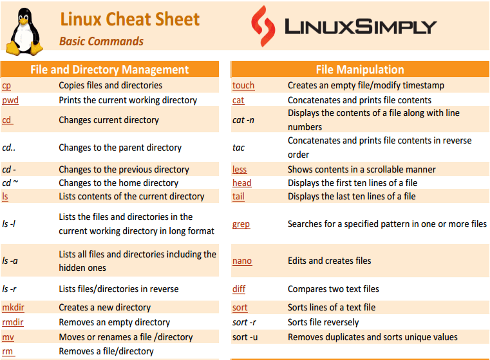Linux command is a set of instructions for carrying out a certain action in Linux. In this article, I will illustrate a basic Linux commands cheat sheet to make your journey with the Linux command line easier. Type these commands into the terminal to handle everything from files and directories to processes and more.
Download Basic Linux Commands Cheat Sheet
What is a Linux Command?
A Linux command is a text-based interface that allows you to communicate with the Linux operating system. The commands are inserted into a terminal which is then passed to a shell that tells the operating system what to do. Linux command is a great alternative to Graphical User Interface (GUI) as it is much faster and more efficient. You can perform all tasks with commands that can be done using the GUI.
Basic Linux Commands List
Here I have categorized all the basic commands in Linux. You can also find that some commands are mentioned with their necessary options. For your better understanding, the structure of a Linux command is
Command -options arguments parametersFile and Directory Management
In this category, you will find commands that can be used to copy, make, and remove files; create directories; and navigate through these.
Under this section, you can find commands which will assist you in editing your files and show contents in your desired ways. Here, you will get to know how you can change the permission of a file or directory: This section consists of commands that can be used to control the operating system just by using the command line. Commands for system and process management are: Commands for package installation are: Commands for file compression are: If you are searching for a pattern in a file content or want to locate files in your system these basic commands are here to help you. Linux has huge commands and options to offer. It’s ok if you can’t memorize all these. Use the built-in documentation command to get help. Commands to get system information are: You can easily add or remove a user in your system using the following commands. Finally, we have listed more commands that may help you in your Linux journey. If you are just starting or are still in the learning phase with Linux, these are a few basic commands you will need to know. Furthermore, these commands were comprehensive enough to cover virtually every job performed from the Linux command line. Some basic Linux commands are as follows: In Linux, sudo stands for superuser do, it allows users to execute commands as a superuser. And superuser is the root user in the Linux system having the administrative privileges to perform different actions that regular users can not do. There is no straightforward answer to this question. In fact, it depends on your project’s needs and your personal preferences. Some popular Linux distributions include Ubuntu, Fedora, Arch Linux, CentOS, etc.Command
Description
cp
Copies files and directories
pwd
Prints the current working directory
cd
Changes current directory
cd..
Changes to the parent directory
cd –
Changes to the previous directory
cd ~
Changes to the home directory
ls
Lists contents of the current directory
ls -l
Lists the files and directories in the current working directory in long format
ls -a
Lists all files and directories including the hidden ones
ls -r
Lists files/directories in reverse
mkdir
Creates a new directory
rmdir
Removes an empty directory
mv
Moves or renames a file /directory
rm
Removes a file/directory
rm -i
Prompts system confirmation before deleting
rm -r
Deletes a file/directory recursively
rm -d
Deletes empty folders
File Manipulation
Command
Description
touch
Creates an empty file/modify timestamp
cat
Concatenates and prints file contents
cat -n
Displays the contents of a file along with line numbers
tac
Concatenates and prints file contents in reverse order
less
Shows contents in a scrollable manner
head
Displays the first ten lines of a file
tail
Displays the last ten lines of a file
grep
Searches for a specified pattern in one or more files
nano
Edits and creates files
diff
Compares two text files
sort
Sorts lines of a text file
sort -r
Sorts file reversely
sort -u
Removes duplicates and sorts unique values
Permissions
Command
Description
chmod
Modifies a file or directory’s read, write, and execute permissions
chown
Changes the ownership of a file, directory, or symbolic link to a specified username.
chgrp
Changes the group ownership of a file or directory
Control System
Command
Description
poweroff
Shuts down the system
reboot
Restarts the system
shutdown
Shuts down or reboots the system
System and Process Management
Command
Description
sudo
Allows a user to run a command with the privileges of another user
ps
Lists the running processes on a system
kill
Terminates running processes on a system
killall
Terminates all processes with a specified name
df
Displays the amount of disk space used and available on a file system
du
Estimates file space usage
Package Installation
Command
Description
apt install [package]
Installs software packages from the Ubuntu package repository
apt-get install
Performs package management tasks such as installing, upgrading, and removing packages
File Compression
Command
Description
tar
Creates, views, and extracts files from an archive file
zip
Creates, views, and extracts files from a compressed archive file
unzip
Extracts files from a compressed archive file in the ZIP format
gzip
Compresses files or directories to reduce their size
bzip2
Compresses files or directories to reduce their size
Search
Command
Description
grep ‘pattern’ files
Searches for a specified pattern or regular expression in one or more files and display the matching lines
grep -r pattern dir
Searches for a specified pattern or regular expression recursively in a directory and its subdirectories, and display the matching lines.
locate
Locates files and directories on the system
find
Locates files and directories on the system
find -empty
Searches for empty files
Help Documentation
Command
Description
man
Displays the manual page of a command or utility
System Information
Command
Description
date
Displays and sets system date and time
cal or ncal
Displays the calendar of the current month
who
Displays information about currently logged-in user
whoami
Displays the user name of the current user logged in
uname
Displays information about the current system and operating system
hostname
Displays or set the hostname of the current system
hostnamectl
Queries or modifies the hostname and related settings of the current system
history
Displays a list of previously executed commands in the terminal
history -c
Clears the history list of previously executed commands
df
Shows information about both total and available space on a file system
User Management
Command
Description
useradd
Creates a new user account on the system
userdel
Deletes a user account from the system
passwd
Changes a user’s password
groupadd
Adds a new group to the system
groupdel
Deletes an existing group from the system
Id
Displays the user and group IDs associated with the current user
su
Switches to another user account
Miscellaneous
Command
Description
echo
Displays a line of text or a variable value on the command line
clear
Clears the terminal window
wc
Counts the number of lines, words, and characters in a file
vim
Texts editor for editing text files
ping
Checks the connectivity between two network devices
exit
Exits the current shell session
htop
Displays the system’s process real-time process activity
shred
Securely deletes the files by overwriting multiple times
w
Displays information about the currently logged-in users and their activities
ps
Displays the running processes
whatis
Displays a brief description of a command
wget
Downloads files from the internet
Conclusion
People Also Ask
What are the basic commands of Linux?
What is sudo in Linux?
Which is the best Linux?
FUNDAMENTALS
A Complete Guide for Beginners


This is very useful content
Thank you! Glad to hear, this was useful to you. Stay connected with us for more amazing contents!